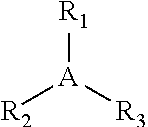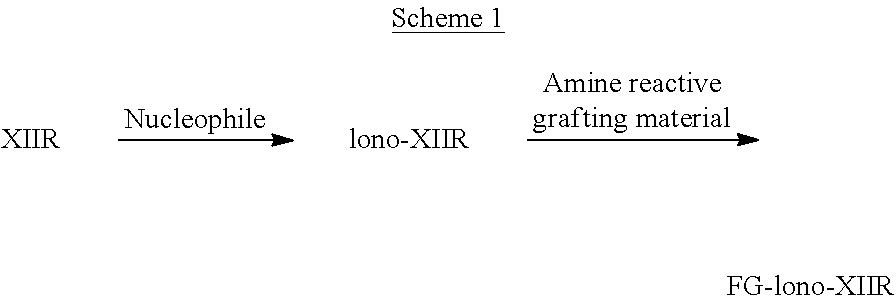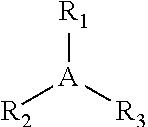Butyl rubber ionomer-thermoplastic graft copolymers and methods for production thereof
- Summary
- Abstract
- Description
- Claims
- Application Information
AI Technical Summary
Benefits of technology
Problems solved by technology
Method used
Image
Examples
examples 1a-4a
[0090]The butyl ionomer used in these examples were derived from LANXESS Bromobutyl 2030 and triphenylphosphine and had an ionic content of 0.5 mol % as well as a Mooney viscosity of 58. This set of examples was carried out in absence of thermoplastic in order to allow for processing and characterization of the resulting extrudates in solution. The butyl polymers were dusted with talc (7 phr). The extrudate composition is stated in Table 2 for each example. The composition was extruded as described above. The extrudates were purified and subjected to IR and 1H NMR analysis. Table 2 furthermore states the absence or presence for spectroscopic evidence for MAH grafting (i.e. IR absorbance at 1780 cm1 and resonances in the 1H NMR spectrum at 3.2 and 3.4 ppm).
TABLE 2Example1a2a3a4aExample typecomparativecomparativecomparativeinventiveLANXESS Butyl10010000402Butyl ionomer00100100MAH (phr)c)0202Irganox 10102222(phr)c)Talcc)4242IR: MAH-absentabsentabsentpresentabsorbance at1780 cm−1NMR:n.d...
examples 1b-4b
[0092]The butyl ionomer used in these examples were derived from LANXESS Bromobutyl 2030 and triphenylphosphine and had an ionic content of 0.5 mol % as well as a Mooney viscosity of 58. This set of examples was carried out in presence of thermoplastic (Durethan CI 31 F). The butyl polymers were dusted with talc (7 phr). The extrudate composition is stated in Table 3 for each example. Extrusion took place at 219° C. average barrel temperature, 150 rpm. With exception of Durethan CI 31 F, all ingredients were fed into the extruder in Zone 0 with a rate of 5 kg h−1; Durethan CI 31 F was added to the extruder via a side stuffer located at Zone 8 at a rate of 4.75 kg h−1. The extrudates were pelletized, dried and injection molded into test specimen for further characterization by stress-strain measurements and extraction.
TABLE 3Example1b2b3b4bExample typecomparativecomparativecomparativeinventiveLANXESS Butyl10010000402 (phr)Butyl ionomer00100100(phr)Durethan CI 31 F103103103103(phr)MAH...
examples 5-9
[0094]The butyl ionomer used in Examples 5-9 was derived from LANXESS Bromobutyl X2 and triphenylphosphine and had an ionic content of 0.3 mol % and a Mooney viscosity of 56. For Examples 5-9, a composition of 100 phr Ionomer with 3 phr talcum, 2 phr maleic anhydride and 1 phr Irganox 1010 were extruded using a co-rotating twin-screw extruder from Leistritz with a screw diameter of 27 mm and an L / D ratio of 57 at a throughput of 15 kg / h and 350 rpm using different temperature profiles. The temperature set values for the barrels (Zones 0-13 and Die) are given in Table 4. The Mooney viscosity and amount of grafted MAH, as determined from signals in the 1H NMR spectra of the Diels-Alder adduct formed for the individual examples is reported in Table 5. Results from Table 5 show that the higher the temperature, the higher is the amount of grafting achieved and the lower is the Mooney viscosity of the extrudate.
TABLE 4TemperatureprofileBarrel#185#200#215#230#2450 25° C. 25° C. 25° C. 25° ...
PUM
| Property | Measurement | Unit |
|---|---|---|
| Temperature | aaaaa | aaaaa |
| Ultimate tensile strength | aaaaa | aaaaa |
| Ultimate tensile strength | aaaaa | aaaaa |
Abstract
Description
Claims
Application Information
 Login to View More
Login to View More - R&D
- Intellectual Property
- Life Sciences
- Materials
- Tech Scout
- Unparalleled Data Quality
- Higher Quality Content
- 60% Fewer Hallucinations
Browse by: Latest US Patents, China's latest patents, Technical Efficacy Thesaurus, Application Domain, Technology Topic, Popular Technical Reports.
© 2025 PatSnap. All rights reserved.Legal|Privacy policy|Modern Slavery Act Transparency Statement|Sitemap|About US| Contact US: help@patsnap.com



